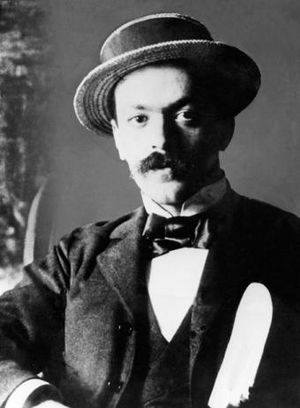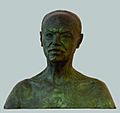Italo Svevo facts for kids
Quick facts for kids
Italo Svevo
|
|
|---|---|

Portrait of Svevo
|
|
| Born |
Aron Ettore Schmitz
19 December 1861 |
| Died | 13 September 1928 (aged 66) Motta di Livenza, Italy
|
| Nationality | Italian |
| Occupation | Novelist, short story writer, playwright, businessman |
|
Notable work
|
La coscienza di Zeno |
| Spouse(s) | Livia Veneziani |
Aron Ettore Schmitz (born December 19, 1861 – died September 13, 1928) was an Italian writer and businessman. He is much better known by his pen name, Italo Svevo.
Svevo was a close friend of the famous Irish writer James Joyce. He is seen as a pioneer of the psychological novel in Italy. His most famous work is the classic modernist novel La coscienza di Zeno (1923). This book had a big impact on literature.
Contents
Early Life and Education
Italo Svevo was born in Trieste. At that time, Trieste was part of the Austrian Empire. His father was Jewish German, and his mother was Italian. Svevo was one of seven children. From a young age, he loved reading books. He enjoyed works by famous writers like Goethe, Schiller, and Shakespeare. He also read classic French and Russian stories.
Svevo was a citizen of the Austro-Hungarian Empire until the end of the First World War. He spoke Italian as a second language. This was because he usually spoke the local Triestine dialect. Because his father was German, Svevo and his brothers went to a boarding school in Germany. There, he learned to speak German very well.
After returning to Trieste in 1880, Svevo continued his studies. However, his father's glassware business failed. This meant Svevo had to start working to help his family. He worked as a bank clerk for 20 years. This experience later inspired his first novel, Una vita (1892).
While working at the bank, Svevo wrote for an Italian newspaper. He also started writing plays, though he rarely finished them. He began working on Una vita in 1887. Svevo believed in humanistic and democratic socialism. This made him a pacifist. He also supported the idea of a European economic union after the war.
Family and Business Ventures
After his parents passed away, Svevo married his cousin Livia Veneziani in 1896. Livia later convinced him to convert to Catholicism. However, Svevo himself was an atheist. He joined his wealthy father-in-law's paint business. This company made special industrial paint for naval warships.
Svevo was very successful in growing the business. He traveled to France and Germany for work. He even set up a branch of the company in England. For a time, Svevo lived in Charlton, south-east London. He wrote letters to his wife about his experiences there. These letters showed the cultural differences he noticed in England. His old home in Charlton now has a special blue plaque to remember him.
Writing Career
Svevo started writing short stories in 1880. He chose the pen name "Italo Svevo" for his first novel. "Italo Svevo" means "Italus the Swabian." He published Una vita in 1892, but it was not very popular.
His second novel, Senilità (1898), also did not do well. In 1919, he began writing La coscienza di Zeno. This book is known in English as Zeno's Conscience or Confessions of Zeno.
Zeno's Conscience
In 1923, Italo Svevo published his famous psychological novel, La coscienza di Zeno. This book shows Svevo's interest in the ideas of Sigmund Freud. The story is written as the memories of a character named Zeno Cosini. Zeno writes these memories because his psychoanalyst asked him to. When it was first published, Svevo's novel received almost no attention in Italy.
The book might have been forgotten if not for James Joyce. Joyce met Svevo in 1907 when he taught Svevo English in Trieste. Joyce read Svevo's earlier novels, Una vita and Senilità.
Joyce strongly supported Zeno's Conscience. He helped get it translated into French and published in Paris. There, critics loved the book. This led Italian critics, like Eugenio Montale, to discover it. Zeno Cosini, the main character, was much like Svevo himself. He was a businessman who was interested in Freudian ideas. Svevo also inspired Leopold Bloom, a character in Joyce's famous novel Ulysses.
Zeno's Conscience mostly takes place in Trieste. Svevo used humor and sarcasm in his descriptions of Trieste. He especially focused on his hero, Zeno. Zeno is a man who cheats on his wife and lies to his psychoanalyst. He tries to explain himself by looking back at his memories.
There is a final interesting link between Svevo and Zeno. Zeno sought psychoanalysis to understand why he struggled with smoking. He wrote in his memoirs that each time he decided to quit, he felt a great thrill. He felt like he was starting life fresh. But this feeling was so strong that he would smoke again. He did this just so he could stop again and feel that thrill once more.
Death
Svevo was in a serious car accident. He was taken to a hospital in Motta di Livenza. His health quickly got worse. As he was dying, he asked a visitor for a cigarette. The visitor said no. Svevo replied, "That would have been my last." He passed away that afternoon.
Legacy
Svevo is considered a very important figure in early 20th-century Italian literature. He, along with Luigi Pirandello, influenced many Italian writers who came after them.
Even though he only became famous for his writing later in life, Svevo is celebrated as one of Italy's best writers. This is especially true in his hometown of Trieste. There is a statue of him in front of the Museum of Natural History in his honor.
The following places are named after him:
- Istituto Comprensivo Italo Svevo in Trieste, Italy
- Liceo Italo Svevo in Cologne, Germany
Selected Works
Novels
- Una vita (1892). A Life, trans. Archibald Colquhoun (1963).
- Senilità (1898). As a Man Grows Older, trans. Beryl de Zoete (1932); later as Emilio's Carnival, trans. Beth Archer Brombert (2001).
- La coscienza di Zeno (1923). Confessions of Zeno, trans. Beryl de Zoete (1930); later as Zeno's Conscience, trans. William Weaver (2003).
Novellas
- La novella del buon vecchio e della bella fanciulla (1926). The Nice Old Man and the Pretty Girl.
- Una burla riuscita (1926). A Perfect Hoax, trans. J. G. Nichols (2003).
Short story collections
- La novella del buon vecchio e della bella fanciulla, e altre prose inedite e postume (1929, posthumous). The Nice Old Man and the Pretty Girl and Other Stories, trans. L. Collison-Morley (1930).
- Corto viaggio sentimentale e altri racconti inediti (1949, posthumous). Short Sentimental Journey and Other Stories (1967).
Other
- Saggi e pagine sparse (1954, posthumous). Essays and Scattered Pages.
- Commedie (1960, posthumous). Dramatic works.
- Lettere (1966, posthumous). Correspondence with Eugenio Montale.
- Further Confessions of Zeno (1969, posthumous). Fragments of a sequel to La coscienza di Zeno; trans. Ben Johnson and P. N. Furbank. Includes: "The Old Old Man"; "An Old Man's Confessions"; "Umbertino"; "A Contract"; "This Indolence of Mine"; and Regeneration: A Comedy in Three Acts.
- A Very Old Man (2021, posthumous). Five short stories, trans. Frederika Randall.
Images for kids
See also
 In Spanish: Italo Svevo para niños
In Spanish: Italo Svevo para niños






